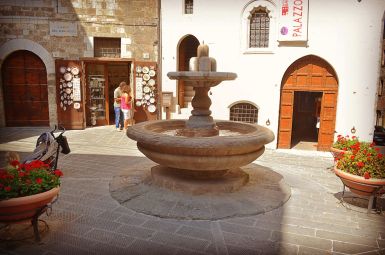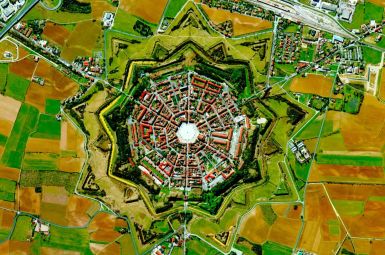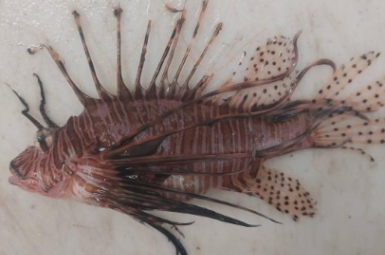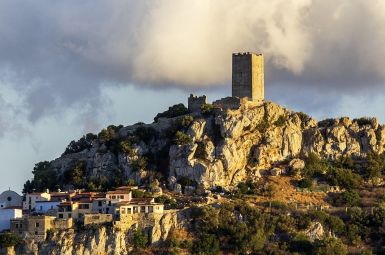
Il Borgo di Melfi
Melfi: La Capitale Imperiale Incorniciata dal Vulcano
Melfi (PZ) non è solo una città, è un’epopea. Qui, tra le pendici boscose del Monte Vulture, la storia non è un ricordo sbiadito, ma una maestosa realtà tangibile che ha plasmato il destino del Sud Italia. Dalle fondamenta normanne alla corte di Federico II, Melfi è il punto d’incontro tra la potenza militare e la raffinatezza culturale, il luogo dove si è scritto il diritto medievale.L’Età d’Oro: Dal Normanno allo Splendore Svevo
Melfi ha ricoperto un ruolo geopolitico di primissimo piano nel Medioevo. Fu la prima capitale del Contado di Puglia (sotto i Normanni) e la sede di cinque concili papali. Ma il suo momento di massima gloria è indissolubilmente legato a:Il Castello di Melfi: La Fortezza di Federico II
Dominante il borgo, questo maniero è uno dei castelli più importanti e suggestivi del Mezzogiorno. Nato come avamposto normanno nell’XI secolo, fu l’imperatore Federico II di Svevia a trasformarlo in una delle sue dimore predilette.- La Costituzione di Melfi (1231): Proprio tra queste mura fu promulgato il celebre “Liber Augustalis” o Costituzioni di Melfi, il primo corpo legislativo moderno d’Europa.
- L’Eredità Doria: Successivamente, la fortezza passò alla famiglia Doria, che la trasformò in una splendida residenza nobiliare, aggiungendo elementi rinascimentali che ne mitigano l’aspetto militare.
La Fede e la Legge: I Simboli del Potere
Passeggiando nel centro storico, si respira l’aria solenne delle istituzioni che hanno governato il Regno:La Cattedrale di Santa Maria Assunta
Fondata per volere di Roberto il Guiscardo, la Cattedrale fu un punto di riferimento per l’intera Chiesa. Nonostante i rimaneggiamenti barocchi causati dai terremoti, il suo imponente Campanile di stile Romanico-Normanno, con le sue bifore e il suo carattere severo, resta un simbolo inconfondibile della sua origine medievale.Le Chiese Rupestri
Nel territorio circostante, Melfi nasconde autentici tesori d’arte bizantina. La Chiesa Rupestre di Santa Margherita e quella di Santa Lucia conservano affreschi di grande valore, che offrono uno sguardo sull’antica spiritualità rupestre, un legame con la civiltà dei Sassi.La Natura e il Gusto: L’Ombra del Vulture
Melfi non è solo pietra e storia; è anche natura rigogliosa. La città si adagia sulle pendici del Monte Vulture, un vulcano spento che ha arricchito il terreno in modo unico.- L’Aglianico del Vulture: È da questi terreni fertili che nasce il celebre Aglianico del Vulture DOCG, un vino rosso austero e profondo, che gli esperti definiscono il “Barolo del Sud.”
- I Laghi di Monticchio: Poco distanti, i due laghi vulcanici (Grande e Piccolo) offrono uno scenario naturale incantevole, un rifugio verde incorniciato da boschi di castagni.
Melfi è l’incrocio tra l’audacia normanna, l’intelletto svevo e la potenza della natura. Sei pronto a esplorare la storia che qui ha deciso il destino di un intero regno?
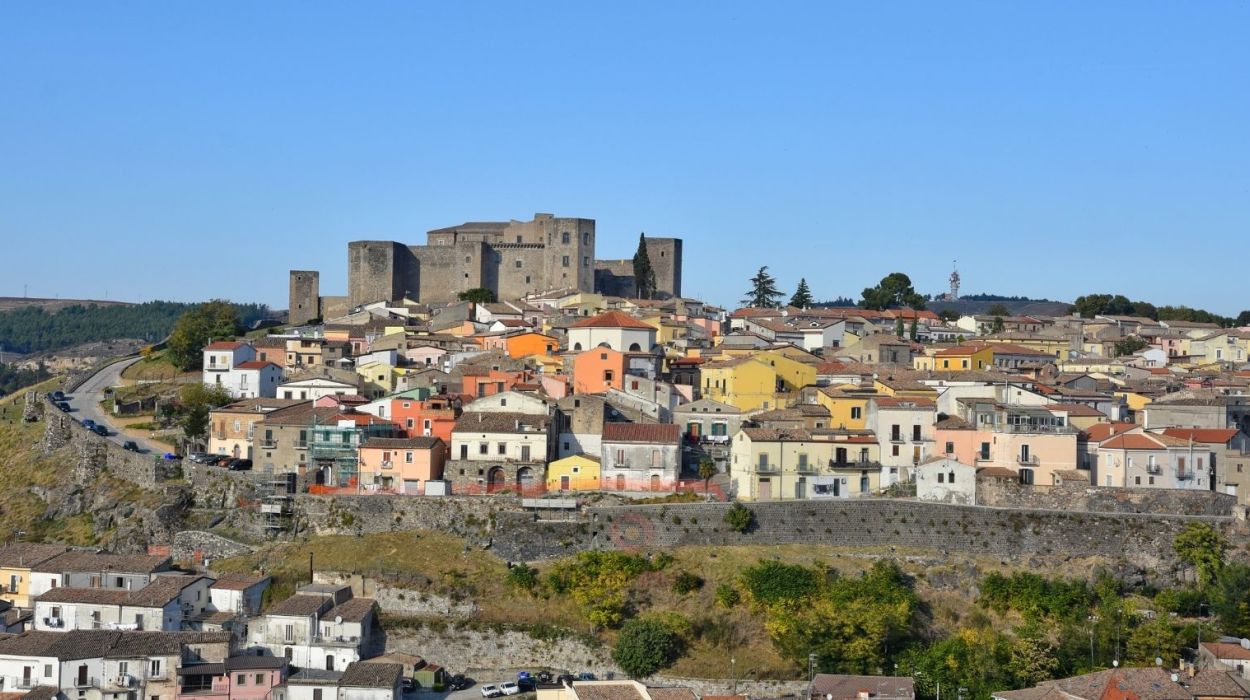
Il Borgo d’Italia
tutto da scoprire ed esplorare
Monumenti
Melfi Monumentale: L’Architettura di un Regno Imperiale
Melfi (PZ) è una fortezza della storia. Ogni monumento che si erge sulle pendici del Vulture non è solo una struttura, ma un capitolo fondamentale del Medioevo italiano. Qui, Normanni e Svevi hanno lasciato un’eredità di pietra e potere che continua a definire l’identità della Basilicata.
Preparati a esplorare i simboli architettonici che rendono Melfi la città di Federico II.
1. Il Castello di Melfi: La Fortezza che Scrisse la Legge
È il monumento simbolo, una delle roccaforti medievali più imponenti e importanti del Sud Italia. Nato per volere dei Normanni (XI secolo), fu ampliato e potenziato da Federico II di Svevia, che lo elesse a sua dimora estiva e, soprattutto, a sede istituzionale del regno.
- Il Cuore del Diritto: All’interno di queste mura, nel 1231, fu promulgato il “Liber Augustalis” (Costituzioni di Melfi), il codice di leggi che riformò il Regno di Sicilia e gettò le basi per la giurisprudenza moderna.
- Architettura e Stile: Oggi, il Castello si presenta come un palinsesto storico: da fortezza militare, con le sue otto torri (tra cui la celebre Torre dell’Orologio), a elegante residenza baronale, dopo i rimaneggiamenti delle famiglie Doria e Caracciolo.
- Museo Custode: Ospita il Museo Archeologico Nazionale del Melfese, dove è custodito il magnifico Sarcofago di Rapolla, un capolavoro scultoreo di età romana, ritrovato nel territorio circostante.
2. La Cattedrale e il Campanile Normanno: Fede e Potere
Nel cuore della città si erge la Cattedrale di Santa Maria Assunta, che testimonia il ruolo di Melfi come centro ecclesiastico di prim’ordine (fu sede di cinque concili papali).
- Il Campanile Superstite: Sebbene la chiesa abbia subito rifacimenti in stile barocco dopo i gravi terremoti, l’elemento di maggiore rilievo è l’imponente Campanile, costruito nel 1153 per volere di Ruggero II. Questa torre conserva il suo maestoso e austero stile Romanico-Normanno, con i suoi tre ordini di bifore, distinguendosi nettamente dal resto della piazza.
3. Le Porte Medievali: Ingressi alla Storia
Le antiche mura perimetrali di Melfi conservano ancora oggi alcuni degli ingressi originari, testimonianza dell’assetto difensivo della città.
- Porta Venosina: È la porta più celebre, risalente al XIII secolo. Con il suo caratteristico arco ogivale e affiancata da torri cilindriche, rappresenta il suggestivo accesso al cuore medievale del borgo. Varcare questa soglia è un vero e proprio passaggio nel tempo.
4. Le Chiese Rupestri: L’Arte Nascosta
Nei dintorni del centro abitato si trovano gioielli di rara bellezza scavati nella roccia, testimoni dell’antica civiltà rupestre:
- Santa Margherita e Santa Lucia: Queste chiese rupestri conservano importanti cicli di affreschi di arte bizantina (XIII secolo), di grande impatto visivo e spirituale. In particolare, nella Chiesa di Santa Margherita si trova il celebre affresco del “Monito dei Morti”, in cui la figura dell’imperatore Federico II si confronta con l’ineluttabilità della morte.
A Melfi, ogni passo è un dialogo con l’autorità imperiale e il genio architettonico. Non limitarti a osservare; esplora le fondamenta di un regno.
Curiosità
Melfi Segreta: Le Curiosità Che Hanno Plasmato l’Impero
Melfi (PZ) non è solo un castello su una collina; è un concentrato di storia e potere, un luogo dove le leggi medievali si sono mescolate alla bellezza della natura vulcanica. Pensavi di conoscerla? Preparati a scoprire i dettagli meno noti che rendono la città di Federico II un gioiello inimitabile.
Ecco le curiosità che ti faranno vedere Melfi con occhi nuovi:
1. La Capitale di Diritto, non solo di Fatto
Melfi non è stata solo una delle tante residenze di Federico II di Svevia: è stata il cuore legislativo del suo impero.
- Qui è Nato lo Stato Moderno: Nel 1231, all’interno del suo maestoso Castello, Federico II promulgò le “Costituzioni di Melfi” (o Liber Augustalis), il primo codice di leggi di un moderno stato laico e centralizzato d’Europa. Stai camminando nel luogo dove è stato scritto un capitolo fondamentale della giurisprudenza occidentale.
2. Il Sarcofago che Viene dall’Oriente
Nel Museo Archeologico Nazionale del Melfese, all’interno del Castello, è custodito un reperto straordinario che testimonia gli antichi scambi culturali della regione: il Sarcofago di Rapolla.
- Il Mistero della Dama: Questo sarcofago romano, finemente lavorato, non è di produzione locale. Si tratta di un capolavoro del II secolo d.C. proveniente dall’Asia Minore (Turchia occidentale), che ritrae sul coperchio la defunta in posizione sdraiata. È la prova di quanto fossero estesi i contatti commerciali e culturali tra la Lucania e il Mediterraneo orientale già in epoca romana.
3. I Due Gemelli Vulcanici
Melfi si trova alle pendici del Monte Vulture, un vulcano spento che ha donato alla zona una fertilità unica.
- I Laghi di Monticchio: A poca distanza dal borgo, i Laghi di Monticchio non sono laghi normali: occupano i crateri principali del vulcano. Il Lago Grande e il Lago Piccolo sono due specchi d’acqua gemelli e separati, un’oasi naturalistica che è il polmone verde della zona e la fonte della ricchezza agricola locale.
4. Il Monito Finale di Federico II
Nelle vicinanze di Melfi si trova la suggestiva Chiesa Rupestre di Santa Margherita, un tesoro di arte bizantina scavato nella roccia.
- L’Affresco del Destino: Qui è conservato un affresco unico nel suo genere, il “Monito dei Morti”, in cui l’imperatore Federico II è raffigurato insieme a un altro regnante davanti a tre scheletri. Il messaggio, tipico dell’arte medievale, è un memento mori (ricorda che devi morire), che ricorda come la ricchezza e il potere siano effimeri di fronte alla morte, anche per il grande e illuminato imperatore.
5. Il Vino come Eredità del Vulcano
La ricchezza del sottosuolo vulcanico non ha solo creato paesaggi, ma anche sapori inimitabili.
- L’Aglianico del Vulture DOCG: Questo vino rosso è considerato dagli esperti il “Barolo del Sud”. La sua struttura, la sua complessità e la sua longevità sono dirette conseguenze dei terreni lavici e minerali del Vulture. A Melfi, il vino è storia geologica in bottiglia.
Melfi ti aspetta per svelarti i suoi segreti, dove la legge, l’arte e il vulcano si incontrano. Quale scoperta storica ti affascina di più?
Personaggi
Melfi: La Stirpe di Uomini e Visionari del Vulture
Melfi (PZ), la città che ospitò imperatori e concili papali, non ha solo plasmato la legge e l’architettura; ha dato i natali a personalità la cui influenza ha attraversato i secoli, dalla politica all’economia, fino alla fede.
Ecco gli illustri figli di Melfi che hanno portato la luce del Vulture in Italia e nel mondo:
Francesco Saverio Nitti: L’Economista e Statista (1868 – 1953) 🇮🇹
È senza dubbio il melfitano più influente nell’Italia contemporanea, una figura chiave che ha ridefinito il panorama politico ed economico del primo Novecento.
- Il Genio Riformatore: Nato a Melfi, Nitti fu un economista di fama internazionale, un accademico e un politico di primissimo piano. Ricoprì cariche fondamentali, arrivando a essere Presidente del Consiglio dei Ministri del Regno d’Italia tra il 1919 e il 1920, in uno dei periodi più turbolenti della storia nazionale.
- La Voce del Mezzogiorno: Da lucano, dedicò gran parte dei suoi studi alla Questione Meridionale, evidenziando la necessità di investimenti e riforme strutturali per il Sud. Ancora oggi è un punto di riferimento per l’analisi economica e sociale del Paese.
Manfredi di Sicilia: Il Re Nato in Terra Lucana (1232 – 1266) 👑
Sebbene il legame sia più spesso associato al vicino borgo di Venosa (per la vicinanza del castello dove nacque), la sua origine è strettamente legata alla corona sveva di Melfi.
- Il Figlio di Federico II: Manfredi, figlio naturale di Federico II e Bianca Lancia, trascorse i suoi anni formativi nei castelli del Vulture. Divenne Re di Sicilia e fu l’ultimo grande esponente della dinastia Sveva a difendere il potere imperiale in Italia contro l’avanzata angioina. La sua figura è immortalata nella storia e nella letteratura (Dante lo collocò nel Purgatorio).
Giovanni Berardi: Il Cardinale Pacificatore (1380 – 1449) 🕊️
In un’epoca di scismi e conflitti ecclesiastici, Melfi diede i natali a una figura di alto profilo nella Chiesa.
- L’Uomo di Chiesa: Giovanni Berardi fu nominato Cardinale e Arcivescovo di Taranto. È ricordato soprattutto per il suo ruolo di diplomatico e pacificatore.
- Il Concilio di Basilea: Berardi fu un protagonista cruciale del Concilio di Basilea, dove lavorò intensamente per sanare le divisioni interne alla Chiesa, dimostrando un’abilità politica e una dedizione alla fede degne di nota.
L’Eredità Giuridica: I Vescovi e i Funzionari del Regno
Melfi, in quanto capitale legislativa, attrasse e formò molteplici figure nell’ambito del diritto e dell’amministrazione che, pur non essendo noti al grande pubblico come Nitti, furono cruciali per il Regno. Molti Vescovi, Giuristi e Funzionari di Corte che operarono per l’applicazione delle Costituzioni di Melfi erano nativi o strettamente legati alla città, contribuendo a diffondere il nuovo modello amministrativo svevo.
Melfi è la prova che la vera forza di un luogo risiede nelle menti che riesce a ispirare. Vieni a scoprire la città che ha formato un Presidente del Consiglio e definito il diritto medievale.
Ricette Tipiche
Melfi: La Cucina Imperiale tra Vulcano e Tradizione
A Melfi (PZ), la gastronomia è un capitolo di storia. Le ricette tipiche nascono dalla terra vulcanica del Monte Vulture, dove la semplicità contadina si sposa con la ricchezza di sapori intensi e territoriali.
La tavola melfitana è robusta, genuina e profondamente radicata nelle materie prime d’eccellenza, con il Vino Aglianico del Vulture come immancabile protagonista.
1. Il Primo Piatto Simbolo: Le Lagane
Se c’è un piatto che racconta la storia del Vulture, sono le Lagane, una pasta antica che affonda le sue radici nella tradizione lucana più autentica.
Lagane e Ceci o Fagioli
Non è una pasta all’uovo, ma un formato semplice di farina di semola e acqua, largo e spesso (simile a una tagliatella rustica). La sua consistenza è perfetta per “catturare” i condimenti poveri ma saporitissimi.
- Il Segreto del Vulture: Spesso sono servite con i ceci o i fagioli locali, aglio e un tocco di peperoncino piccante, onorando la tradizione rurale. Un comfort food storico, che sa di casa e di terra.
2. L’Eroico Condimento: Il Ragù di Carni Miste
Melfi, con le sue tradizioni medievali e pastorali, vanta un ragù che richiede tempo, pazienza e passione.
Ragù di Castrato o Agnello con Orecchiette
Il ragù qui è preparato con carne di agnello o castrato, cotta a fuoco lentissimo per ore. Questo sugo denso, scuro e profumatissimo, viene tradizionalmente utilizzato per condire le orecchiette o altri formati di pasta fresca.
- La Salsiccia Melfitana: Spesso il ragù è arricchito dalla locale Salsiccia Lucana a punta di coltello, che aggiunge un sapore speziato e inconfondibile, rendendo il piatto un inno alla ricchezza carnivora della zona.
3. L’Oro Rosso della Tavola: Il Peperone Crusco
Nessuna tavola in Basilicata è completa senza il suo ingrediente più iconico, utilizzato sia come contorno che come condimento.
Baccalà con Peperoni Cruschi
Sebbene il baccalà sia un pesce, la sua preparazione nel Melfese è completamente terrestre. Il baccalà viene cotto al forno o in umido, ma il colpo di scena è dato dalla guarnizione.
- L’Esaltazione: I Peperoni Cruschi (peperoni dolci essiccati e poi fritti velocemente in olio bollente) vengono spezzettati a pioggia. La loro croccantezza e il sapore agrodolce-affumicato trasformano il piatto, creando un contrasto di consistenze e sapori indimenticabile.
4. Il Dolce Rito: I Sapori delle Feste
Il Sanguinaccio (dolce)
Un dolce che riporta indietro nel tempo, tipico del periodo di Carnevale e della macellazione del maiale. Sebbene la preparazione “originale” sia oggi in disuso per motivi igienico-sanitari, la ricetta moderna utilizza cioccolato fondente, latte, zucchero e spezie (cannella e chiodi di garofano), insaporendo l’impasto con canditi, uva passa e scorze d’arancia.
- Curiosità: Il sanguinaccio melfitano viene servito come crema e spesso accompagnato dai taralli dolci o dalle scorze d’arancia.
Lasciati conquistare dal gusto austero e nobile di Melfi. Il connubio perfetto? Questi piatti con un calice del loro Re: l’Aglianico del Vulture DOCG.
Sei pronto per un banchetto da Imperatore?
